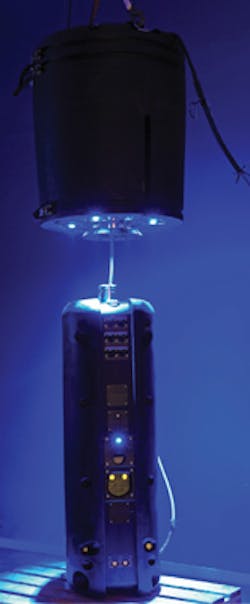Aquaculture imaging: 3D vision system helps rid salmon of sea lice
In Norway, commercial fish farming is one of the largest industries after oil and gas production. Indeed, the country is the world's leading producer of Atlantic salmon and the second largest seafood exporter in the world. To produce such large quantities, salmon are reared in large numbers in densely stocked tanks or enclosures at sea in sea-cages.
"Unfortunately, such farming methods have their drawbacks", says Steinar Laudal, Managing Director of Mestec (Oslo, Norway; www.mestec.no), "one of which is eliminating any sea lice that may be present on the fish." Traditionally, sea lice have been controlled in a number of different ways. These include introducing fish such as the Wrasse into the sea-cages to feed from the lice that may be present on the body of the salmon. Other methods include introducing chemicals such as Hydrogen Peroxide into the tanks to kill the salmon lice. "Unfortunately, because of the large number of fish being farmed, neither method is 100% effective," says Laudal.
To address this, Mestec has supported Stingray Marine Solutions (Oslo, Norway; http://en.stingray.no) to develop an ecologically-friendly salmon delousing system that incorporates off-the-shelf-lighting, cameras and lasers to perform the task. Once submerged in a fish pen, the Stingray system employs cameras to identify the position of parasites on the fish and predict their position and velocity. Having done so, a laser is then fired from the unit which automatically removes the lice from the fish. A video of the system in operation can be found at: http://en.stingray.no/page/6024/Video.
"Because the lice present on the fish can vary in both color and size through their life-cycle, it is necessary to capture multiple images of salmon lice and analyze these images to determine their location on this fish," says Laudal. To do so, a bank of 12 blue 450nm Luxeon LEDs from Lumileds (San Jose, CA, USA; www.lumileds.com) mounted on the Stingray node are used to illuminate an approximately one square meter area of water in front of the system. This wavelength of light has the best transmission in water and can therefore be used to produce high-contrast images.
To capture these images, a pair of GS3-U3-50S5M-C Grasshopper cameras with Sony 5Mpixel ICX625 CCD sensors from Point Grey (Richmond, BC, Canada; www.ptgrey.com) placed horizontally from one another captures images of the fish at 15fps. Captured images are then transferred to the PC for analysis. Here, the location of the eye of the fish is determined as well as the location, size and contrast of any lice that may be present. This data is then compared with a large database of pre-stored images of salmon lice in different sizes, locations and contrasts. This is performed using the graphics card in the host PC.
After comparing two images from the stereo pair, the position and velocity of the fish/lice can be computed. "Thus, the system can predict the coordinates at which the lice on the fish might be expected just milliseconds later," says Laudal.
Once the system has determined the position and location of any parasites, the PC then sends a command to a galvo-mirror system from Thorlabs (Newton, NJ, USA; www.thorlabs.com) that is oriented to direct a pulse of light from a high-powered green laser at the location of the parasite. The laser beam is collimated through a beam expander to avoid severe beam divergence. If a fish passes by the system with several lice on its body, the system is fast enough that it can identify and then eliminate several of them. Since the software has predetermined the position of the eyes of the salmon, these are flagged as a no-fire zone, protecting the eyes of the fish from damage from the laser light.
By logging images from the system as this occurs, the effectiveness of the imaging and control software running on the system can be evaluated and, if necessary, improved. The images captured by the cameras can also be used by a salmon breeder to monitor the behavior and health of the fish in the cages.
According to Laudal, over 30 Stingray systems are in use in Norway today, where they have been effective at lowering the populations of lice in salmon farms. Stingray Marine Solutions plans to increase production to more than 100 units per year to meet the increase in demand from customers worldwide.

